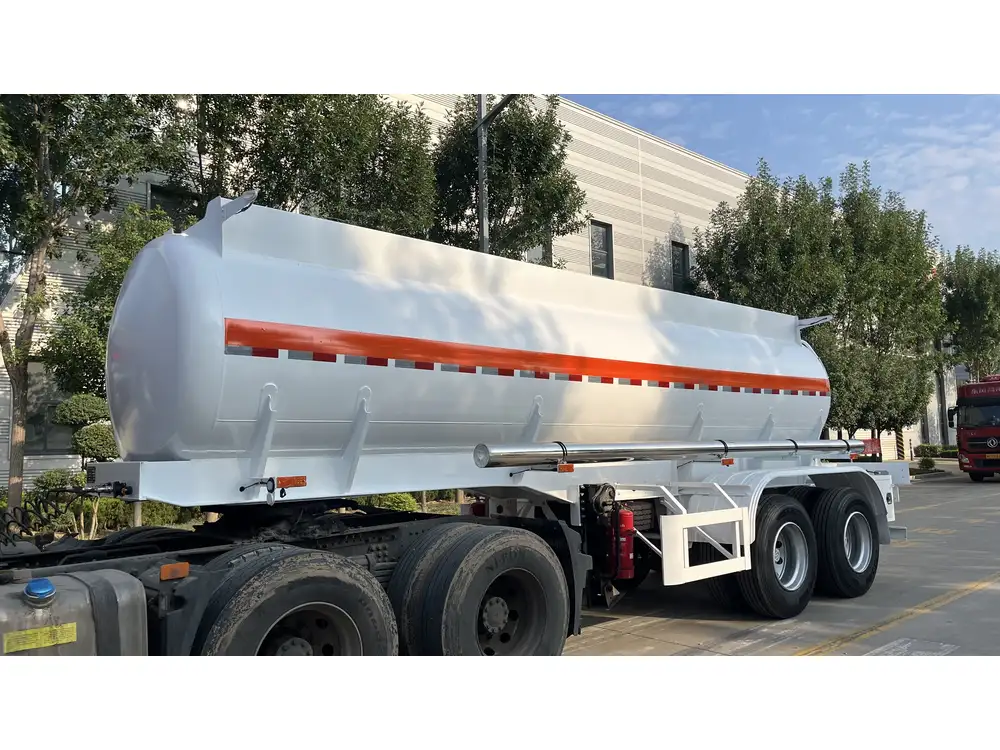When discussing safety and compliance for flatbed trailers, one often overlooked detail is the marker light system. As semi-trailer manufacturers, it is crucial to grasp the various components and regulations that govern these lighting systems to ensure both operational safety and legal conformity.
The Importance of Marker Lights
Marker lights are vital components that enhance the visibility of flatbed trailers, which is especially critical during nighttime operation or inclement weather conditions. With the right marker light configuration, potential hazards are reduced, effectively safeguarding both the trailer and surrounding vehicles. In this section, we will delve deeper into what marker lights are, their purposes, and the regulatory framework that governs them.
What Are Marker Lights?
Marker lights, sometimes referred to as clearance lights, serve several key functions:
- Visibility: They help to delineate the vehicle’s presence on the roadway, alerting passing motorists to its dimensions and position.
- Identification: Marker lights specify whether a vehicle is a trailer, truck, or another type of road user, which can be crucial in busy scenarios.
- Compliance: Adhering to relevant regulations concerning lighting ensures that operators avoid fines and penalties and remain within legal boundaries.

Types of Marker Lights on Flatbed Trailers
Understanding the types of marker lights available for flatbed trailers can enhance operational planning. The following categories represent the primary options for trailer illumination:
| Type of Marker Light | Description | Use Case |
|---|---|---|
| Front Marker Lights | Positioned on the very front edges of the trailer. | Essential for indicating trailer length. |
| Rear Marker Lights | Located at the back of the trailer. | Critical for visibility from behind. |
| Side Marker Lights | Installed along the sides to enhance profile visibility. | Maintains visibility over the trailer’s length. |
| Reflective Tape | Not a light but serves to increase visibility. | Used in combination with lights for added safety. |
How Many Marker Lights Are Required on a Flatbed Trailer?
The regulations concerning the number of marker lights on a flatbed trailer can vary based on regional laws and mandates. However, it is widely accepted that:
- Front: A minimum of two clearance lights must be present on the front corners, ensuring that the width of the trailer is visible.
- Rear: Similar to the front, at least two lights should be installed at the rear corners.
- Side: Depending on the length of the flatbed trailer, additional side marker lights should cover intervals of not more than 10 feet.
Breakdown of Count by Length
| Trailer Length | Required Front Lights | Required Rear Lights | Required Side Lights |
|---|---|---|---|
| Up to 20 feet | 2 | 2 | 2 |
| 20 to 40 feet | 2 | 2 | 3 |
| Over 40 feet | 2 | 2 | 4 or more |
This table indicates the bare minimum requirements established by the Federal Motor Carrier Safety Administration (FMCSA) and similar regulatory bodies across jurisdictions. It is paramount to verify specific state regulations or other local requirements that might mandate additional lights.

Placement: Best Practices for Marker Lights
Placement of marker lights plays an essential role in maximizing their functionality. Here’s a breakdown of some best practices to ensure optimal visibility and compliance:
Front Marker Lights
- Positioning: These should be mounted at the widest point of the trailer, ideally near the top edge.
- Height: They should be between 24 and 54 inches above the ground to prevent obstruction.
Rear Marker Lights
- Alignment: Install these at the back corners in a way that they can be seen from at least 500 feet away.
- Height: Similar to front lights, rear lights should also fall within the 24 to 54-inch range.

Side Marker Lights
- Continuous Coverage: Side lights must be spaced appropriately so that every 10 feet of trailer length has a light.
- Visibility: The lights should be mounted high enough to avoid getting obscured by cargo.
Understanding the Role of Color in Marker Lights
The color of marker lights is more than an aesthetic choice; it carries significant functional importance. According to transportation laws:
- Amber: Typically denotes the front and side marker lights.
- Red: Used for rear marker lights to signal to trailing motorists.
Compliance with Color Regulations
Failure to adhere to these color regulations can result in non-compliance penalties. It is crucial to ensure all lights meet ANSI and FMCSA guidelines, reflecting the correct colors and specifications for trailers.

Technology in Marker Lighting: Innovations to Remember
Recent advancements in technology have introduced alternative lighting options for flatbed trailers. The integration of LEDs, for example, provides numerous advantages over traditional incandescent bulbs:
Benefits of LED Marker Lights
- Longevity: LEDs boast a lifespan significantly longer than standard bulbs, which translates to lower maintenance costs.
- Efficiency: They consume less power, making them an eco-friendlier choice.
- Visibility: The brightness of LEDs is often superior, enhancing safety especially during fog or heavy rain.
Maintenance Best Practices for Marker Lights
Regular maintenance of marker lights is crucial for ensuring safety on the roads. Neglecting these lights can lead to malfunction, increasing the risk of accidents. Below are recommended practices to keep your marker lights in optimal condition:

Routine Inspection Checklist
- Functional Testing: Periodically check each light to ensure it illuminates correctly.
- Cleanliness: Ensure the lens covers are clean and free from debris that may block light emission.
- Wiring Condition: Inspect the wiring connections for wear and corrosion, replacing any damaged sections promptly.
- Compliance Checks: Verify that all lights still meet the required visibility and color regulations.
Repair and Replacement
When a marker light is found to be defective, it should be replaced immediately with a compatible option. Given the brittle nature of some older bulb types, upgrading to LED systems can often be a wise choice.
Conclusion: Prioritizing Safety and Compliance with Marker Lights
In summary, when evaluating the necessary components and standards for marker lights on flatbed trailers, it is evident that safety and compliance require rigorous attention to detail. Understanding the necessary regulations for the number, placement, type, and color of lights is critical for manufacturers and operators alike.
Investing time and resources into proper installation and maintenance of marker lights can significantly enhance road safety, reduce liability, and promote compliance with local laws. By embracing these principles, manufacturers and owners can ensure their flatbed trailers remain compliant, safe, and reliable on the busy highways of today.



